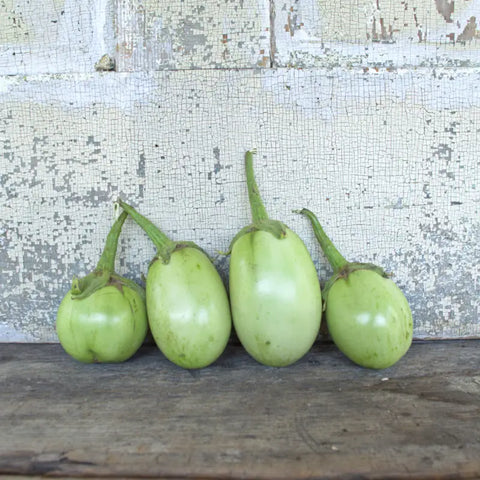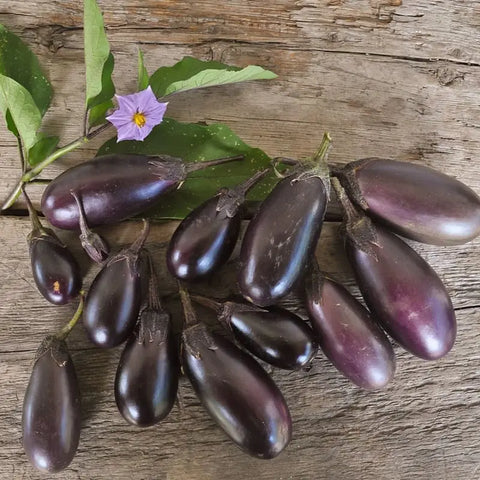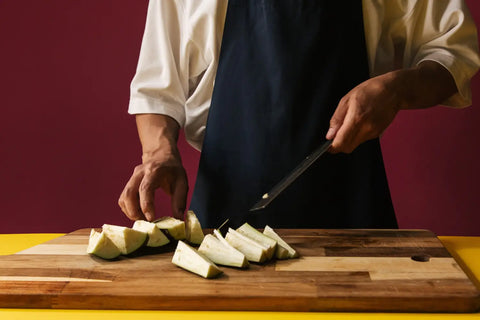A nourishing vegetable that's treasured in cuisines across the globe, the eggplant carries many titles.
This glossy, garden beauty comes in all shapes, shades and sizes: purple, striped, orange, skinny, or soft, white, and egg-like - as it was so aptly named.

First discovered in India over 4000 years ago, the solanum melongena is one of today’s most popular vegetables (well, technically, it’s a fruit but you know how this goes). There, it’s known as ‘Brinjal’ and holds the title of the ‘King of vegetables.’ In Sanskrit, the plant is called ‘Vantingan’ which loosely translates to ‘wind removing’ presumably due to its high fiber content.
The Italians call it 'Melenzana,' its Latin name which the English then mistranslated to ‘mala insana’ or ‘mad/raging apple.’ It is a close relative to known poisonous nightshades like belladonna (the devil’s cherries) and brugmansia (Angel’s trumpet) and as a result, many first believed that eating the fruit would make you go mad with anger and delirium!
Centuries later, and there are over 4 million acres dedicated to growing eggplant.
Across the pond, they call it an Aubergine which seems to suit the delicacy of its silky texture. The culinary versatility is impressive: grill it, roast it, toss it in a stir-fry or curry, purée it for baba ganoush or let it shine as the main event in an eggplant parmesan.
Eggplants are hearty, full of fiber and vitamins but have a surprisingly low calorie count. They pack an abundance of antioxidants and anthocyanins specific to blue, red and purple veggies and fruits. Inside these anthocyanins is a neat phytochemical called “NASUNIN” that binds with Iron and removes it from cells in the body.
Delicious and nutritious - seems like an egg-cellent addition to your garden.
Ok, no more egg puns. I’ll leave those to the 'comedy-hens.'

Our top tips on growing eggplant:
- They are heat lovers from germination to fruiting!! Jaci recommends implementing a bottom heat source to encourage germination as temps need to be high: at least 75°F - 80°F.
- Start seeds in low shallow trays to help things heat up quickly.
- Fertilize your seedlings weekly using a diluted strength fertilizer such as Neptune's Harvest - it’s good on all nightshades.
- Once soil temps remain above 65, you can begin to harden off your eggplant transplants.
- Jaci Tip: Lay black plastic over the soil where you’ll be putting your seedlings to help warm it up! When the time comes, amend your soil with a heaping shovel (or two) of fresh compost.
- Want to harvest your fruit early? Grow your eggplant in raised beds or containers - the warmer the soil, the faster they’ll grow! This means greenhouses, row covers and other common measures to keep your garden warm during cold fronts, can be implemented earlier to encourage more growth and extend your harvesting season.
- Hand pollinating will help with earlier fruit sets - if you’re getting antsy.
- Eggplants thrive with a bit of support (don’t we all?) but be sure to introduce your stakes, or support sticks when you transplant so you don’t risk disturbing the roots any more than necessary.
- Fertilize with a liquid fertilizer, or side-dress using a granular one.
- Eggplant shapes can be short, round, oblong, straight or curved but keep an eye on any fruits that appear dramatically misshapen. It could be a sign of inconsistent moisture, low drainage or just plain soggy soil.
- Harvest before the skin loses its luster! The fruit will be heavy and dense but not too tender. Use a sharp tool to separate from the plant. Picking the first fruits when they reach usable size helps accelerate the growth of the other eggplants on the plant.
Tips for cooking:
Slice the ends off of your eggplant but don’t peel the skin - that’s where all the antioxidants are! Cut into 1 inch pieces, long slices like fries, or circles. Lay on a baking sheet atop parchment paper, salt and let the eggplant rest for 20 minutes. Dab lightly with a paper towel. This reduces excess moisture and will help achieve crispiness when roasted in the oven. Preheat to 400 degrees, roast for 15 minutes, flip and roast for another 10 (checking periodically).

Treat it as a main, side, salad base or simply eat it straight off the parchment - no judgment here!
Sources: A Thousand Names for Eggplant - The Odd Pantry, Eggplant; Love it or Leave it - The Vineyard Gazette, Antioxidant Activity of Nasunin - Science Direct


I’m planning on growing eggplants these year in Gro-Bags, similar in concept to CB’s comment (but a bit less sturdier). Having a plant like their “kissin’ cousin” borage nearby could also help with pollination.
I’ve grown several varieties of eggplants in black 10 gallon pots on my patio where it’s sunniest and I get much higher yields. I mulch the soil and am able to water and fertilize easily. It’s so much fun too. If you don’t have a lot of garden space, consider this way of growing them.
I like the Asian eggplants, and i slice in half, brush cut sides with olive oil, salt& pepper, and lay cut-side down on the grill, turming over after 4-5 minutes, til fork goes thru easily, then sprinkle with: oregano, or other herbs of your choice.
Very nice article. We love growing and sharing many varieties and we always try something new each year.